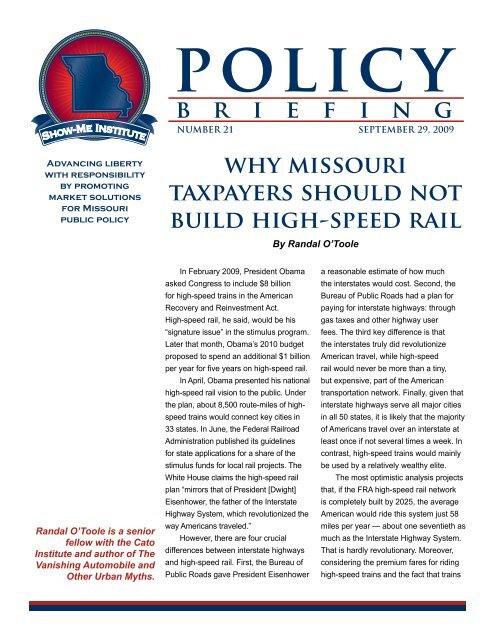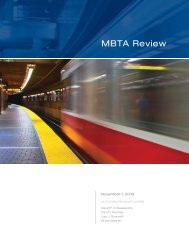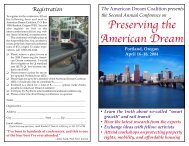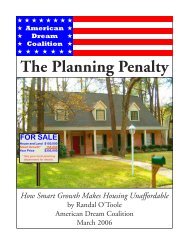Why Missouri Should Not Build High-Speed Rail - American Dream ...
Why Missouri Should Not Build High-Speed Rail - American Dream ...
Why Missouri Should Not Build High-Speed Rail - American Dream ...
You also want an ePaper? Increase the reach of your titles
YUMPU automatically turns print PDFs into web optimized ePapers that Google loves.
policy<br />
b r i e f i n g<br />
NUMBER 21 SEPTEMBER 29, 2009<br />
why missouri<br />
taxpayers should not<br />
build high-speed rail<br />
By Randal O’Toole<br />
Randal O’Toole is a senior<br />
fellow with the Cato<br />
Institute and author of The<br />
Vanishing Automobile and<br />
Other Urban Myths.<br />
In February 2009, President Obama<br />
asked Congress to include $8 billion<br />
for high-speed trains in the <strong>American</strong><br />
Recovery and Reinvestment Act.<br />
<strong>High</strong>-speed rail, he said, would be his<br />
“signature issue” in the stimulus program.<br />
Later that month, Obama’s 2010 budget<br />
proposed to spend an additional $1 billion<br />
per year for five years on high-speed rail.<br />
In April, Obama presented his national<br />
high-speed rail vision to the public. Under<br />
the plan, about 8,500 route-miles of highspeed<br />
trains would connect key cities in<br />
33 states. In June, the Federal <strong>Rail</strong>road<br />
Administration published its guidelines<br />
for state applications for a share of the<br />
stimulus funds for local rail projects. The<br />
White House claims the high-speed rail<br />
plan “mirrors that of President [Dwight]<br />
Eisenhower, the father of the Interstate<br />
<strong>High</strong>way System, which revolutionized the<br />
way <strong>American</strong>s traveled.”<br />
However, there are four crucial<br />
differences between interstate highways<br />
and high-speed rail. First, the Bureau of<br />
Public Roads gave President Eisenhower<br />
a reasonable estimate of how much<br />
the interstates would cost. Second, the<br />
Bureau of Public Roads had a plan for<br />
paying for interstate highways: through<br />
gas taxes and other highway user<br />
fees. The third key difference is that<br />
the interstates truly did revolutionize<br />
<strong>American</strong> travel, while high-speed<br />
rail would never be more than a tiny,<br />
but expensive, part of the <strong>American</strong><br />
transportation network. Finally, given that<br />
interstate highways serve all major cities<br />
in all 50 states, it is likely that the majority<br />
of <strong>American</strong>s travel over an interstate at<br />
least once if not several times a week. In<br />
contrast, high-speed trains would mainly<br />
be used by a relatively wealthy elite.<br />
The most optimistic analysis projects<br />
that, if the FRA high-speed rail network<br />
is completely built by 2025, the average<br />
<strong>American</strong> would ride this system just 58<br />
miles per year — about one seventieth as<br />
much as the Interstate <strong>High</strong>way System.<br />
That is hardly revolutionary. Moreover,<br />
considering the premium fares for riding<br />
high-speed trains and the fact that trains
If trains in the<br />
most heavily<br />
populated<br />
corridor in the<br />
United States<br />
cannot cover<br />
their costs, no<br />
other trains will<br />
come close. In<br />
recent years,<br />
<strong>Missouri</strong>’s<br />
annual operating<br />
subsidy for<br />
Amtrak has<br />
hovered around<br />
$8 million per<br />
year.<br />
will mainly serve downtown areas, most of<br />
that use would be by the wealthy and by<br />
bankers, lawyers, government workers,<br />
and other downtown employees whose<br />
employers pay the fare, while all other<br />
taxpayers would share the cost.<br />
All politics is local, so every member<br />
of Congress will want a piece of the highspeed<br />
rail pie. Initial funding of $8 billion<br />
effectively commits the nation to a $99<br />
billion program, which eventually turns into<br />
a $700 billion program, with actual costs<br />
eventually exceeding $1 trillion.<br />
Despite optimistic forecasts by rail<br />
proponents, passenger fares would rarely<br />
if ever cover high-speed operating costs.<br />
Amtrak operations currently cost federal and<br />
state taxpayers more than $1 billion per year.<br />
According to the bipartisan Amtrak Reform<br />
Council, Amtrak’s trains between Boston and<br />
Washington lost nearly $2.30 per passenger<br />
in 2001. If trains in the most heavily<br />
populated corridor in the United States<br />
cannot cover their costs, no other trains<br />
will come close. In recent years, <strong>Missouri</strong>’s<br />
annual operating subsidy for Amtrak has<br />
hovered around $8 million per year.<br />
JAPAN AND EUROPE<br />
In 1964, Japanese National <strong>Rail</strong>ways<br />
began operating the world’s first high-speed<br />
train, the 135-mph Tokaido Shinkansen, or<br />
bullet train, between Tokyo and Osaka. This<br />
is also the only high-speed train in the world<br />
that has paid for itself, and for good reasons.<br />
First, it was built across flat land at a<br />
time when Japan’s property values and<br />
construction costs were far lower than<br />
today. More important, the Tokaido line<br />
connects three of the world’s largest and<br />
densest metropolitan areas: Tokyo, with<br />
21 million people in 1965 and 33 million<br />
today; Osaka, with 13 million in 1965 and<br />
17 million today; and Nagoya, with 6 million<br />
people in 1965 and 9 million today. Few<br />
other places in the developed world have<br />
such concentrations of people located a few<br />
hundred miles apart.<br />
Meanwhile, as attractive as the bullet<br />
trains are to <strong>American</strong> tourists, residents<br />
of Japan hardly use them. Japanese travel<br />
by train more than the people of any other<br />
nation in the world — about 1,950 miles per<br />
person per year. But high-speed rail carries<br />
only about 20 percent of that travel, or less<br />
than 400 miles per person. Japanese travel<br />
as much on domestic airlines and almost<br />
as much by bus as by high-speed rail, and<br />
they travel by car 10 times as many miles<br />
per year as by high-speed rail.<br />
<strong>American</strong> tourists who visit Europe<br />
often come home wishing that the United<br />
States had a similar transportation system.<br />
Of course, the United States isn’t Europe;<br />
our population densities are lower, and our<br />
incomes are higher, so fewer people would<br />
ride transit even in dense areas.<br />
More importantly, Europe isn’t Europe<br />
either — at least not the Europe that many<br />
<strong>American</strong>s fantasize about. For example, as<br />
of 2007, at least 150 European urban areas<br />
had some form of rail transit, compared with<br />
just 30 in the United States. Yet the average<br />
resident of the EU-15 travels just 95 miles<br />
per year on urban rail transit, compared with<br />
87 for the average <strong>American</strong>. This trivial<br />
difference hardly justifies the huge amount<br />
Europe spends subsidizing urban transit.<br />
ENVIRONMENTAL<br />
COSTS<br />
After studying high-speed rail<br />
proposals in Britain, Professor Roger<br />
Kemp of Lancaster University concluded<br />
that the construction costs dwarf any
savings in operations unless the rail lines<br />
are used to their full capacity. With a<br />
round-the-clock average of just one train<br />
per hour in each direction, and no more<br />
than two trains per hour during the busiest<br />
times of day, even Amtrak’s New York-to-<br />
Washington corridor operates at far from<br />
full capacity.<br />
Electrically powered high-speed trains<br />
produce less greenhouse gases only if<br />
the electricity used is generated from<br />
renewable power sources. Most electricity<br />
in the United States comes from fossil<br />
fuels, with the result that urban rail transit<br />
systems in such cities as Baltimore and<br />
Washington generate as much or more<br />
greenhouse gases, per passenger mile, as<br />
driving an SUV — much less an ordinary<br />
car.<br />
For the sake of comparison, it is far<br />
more cost effective to save energy by<br />
encouraging people to drive more fuelefficient<br />
cars than it is to build and operate<br />
high-speed rail. When considering the<br />
energy required for construction and<br />
reconstruction of high-speed rail lines,<br />
improvements in auto and airline energy<br />
efficiencies, and the high energy cost<br />
required to move trains at higher speeds, it<br />
appears unlikely that high-speed rail would<br />
have any environmental benefits at all.<br />
REGULATING<br />
PROPERTY RIGHTS<br />
<strong>High</strong>-speed rail is only one part of<br />
the Obama administration’s “livability”<br />
campaign to completely reshape <strong>American</strong><br />
lifestyles. In addition to high-speed rail,<br />
this program includes more urban transit<br />
(particularly rail transit), bicycle and<br />
walking paths, encouragement of highdensity<br />
housing, and discouragement<br />
of single-family housing and driving. As<br />
Transportation Secretary Ray LaHood<br />
recently admitted, the ultimate purpose of<br />
this campaign is to “coerce people out of<br />
their cars.”<br />
Despite the terms “livability” and “smart<br />
growth,” unless you are rich, athletic, and<br />
have no children, the government programs<br />
in question create cities that are neither<br />
smart nor livable. Even though there are far<br />
more effective and less expensive ways to<br />
reduce the environmental costs of driving,<br />
smart growth is accepted without question<br />
by many policymakers, reporters, and urban<br />
leaders.<br />
The failure of these policies to have<br />
much of an effect on driving might not<br />
be important were it not for the fact that<br />
the policies impose huge costs on urban<br />
residents. Numerous surveys show that the<br />
vast majority of <strong>American</strong>s say they want to<br />
live in a single-family home with a yard. Yet<br />
livability policies deliberately make this type<br />
of housing unaffordable to low- and even<br />
middle-income families.<br />
BANKERS, LAWYERS,<br />
AND BUREAUCRATS<br />
Amtrak carries between 5 billion and 6<br />
billion passenger miles each year, which is<br />
roughly 0.1 percent of all passenger travel<br />
in the United States. The optimistic analysis<br />
prepared by the Center for Clean Air Policy<br />
predicts that, if the FRA high-speed rail<br />
plan were completed before 2025, it would<br />
carry 25.5 billion passenger miles per year<br />
(5.5 billion of which would be taken from<br />
conventional Amtrak trains). However, 4.8<br />
billion of these passenger miles would<br />
be on the existing Boston-to-Washington<br />
corridor, so the FRA plan would increase<br />
high-speed rail travel by 20.6 billion<br />
Despite the terms<br />
“livability” and<br />
“smart growth,”<br />
unless you are<br />
rich, athletic, and<br />
have no children,<br />
the government<br />
programs in<br />
question create<br />
cities that are<br />
neither smart nor<br />
livable.
7777 Bonhomme Avenue<br />
Suite 2150<br />
Saint Louis, MO 63105<br />
www.showmeinstitute.org<br />
passenger miles.<br />
The Census Bureau projects that the<br />
U.S. population will be 357 million people<br />
in 2025, which means the FRA system will<br />
carry each person an average of 58 miles<br />
per year. In the unlikely event that percapita<br />
driving and flying do not increase,<br />
the FRA system would then carry just 0.3<br />
percent of passenger travel.<br />
STATE-BY-STATE<br />
ANALYSIS<br />
Upgrading the 250 miles between<br />
Kansas City and Saint Louis would cost<br />
taxpayers at least $875 million, or nearly<br />
$150 per <strong>Missouri</strong> resident. In the unlikely<br />
event that Amtrak can keep losses per<br />
passenger as low as those in the New<br />
York–Buffalo or Los Angeles–San Diego<br />
corridors, <strong>Missouri</strong>’s portion of high-speed<br />
rail would have operating losses of $60<br />
million per year, or $10 per resident — and<br />
that is very optimistic.<br />
Significant improvements can be made<br />
to the existing Saint Louis to Kansas City<br />
Amtrak route without the need for highspeed<br />
rail. The current Amtrak route is<br />
plagued by delays because it shares the<br />
line with freight. A recent University of<br />
<strong>Missouri</strong> study for the <strong>Missouri</strong> Department<br />
of Transportation recommended various<br />
ways to improve the current route, and<br />
work on one of those improvements began<br />
in April 2009. If the report’s three primary<br />
recommendations are funded and built, the<br />
average time between Kansas City and<br />
Saint Louis would be reduced by 20 minutes<br />
and delays would be cut by 36 percent, all<br />
for a total cost of between $29.5 million and<br />
$42.5 million.<br />
In 1970, the federal Environmental<br />
Protection Agency began addressing<br />
toxic air pollution in two ways. First, it<br />
encouraged cities to adopt behavioral<br />
solutions such as public transit and<br />
disincentives to driving aimed at getting<br />
people to drive less. Second, it required<br />
technical improvements to automobiles,<br />
such as catalytic converters. The behavioral<br />
solutions failed miserably: between 1970<br />
and 2006, total driving increased by 170<br />
percent and per-capita driving nearly<br />
doubled. The technical solutions, however,<br />
were incredibly successful: despite the<br />
increase in driving, total automotive<br />
emissions of most pollutants declined by<br />
well over 50 percent.<br />
Despite this clear record of success<br />
and failure, some people still want to modify<br />
behavior in order to change <strong>American</strong><br />
single-family home and automotive<br />
lifestyles. The administration’s livability<br />
agenda relies almost exclusively on such<br />
behavioral solutions, including high-speed<br />
rail.<br />
CONCLUSIONS<br />
<strong>High</strong>-speed rail is a technology whose<br />
time has come and gone. What might have<br />
been useful a century ago is today merely<br />
an anachronism that would cost taxpayers<br />
tens or hundreds of billions of dollars, yet<br />
contribute little to <strong>American</strong> mobility or<br />
environmental quality.<br />
The United States can do many things<br />
to cost-effectively improve transportation<br />
networks in ways that save energy, reduce<br />
accidents, and cut toxic and greenhouse<br />
gas emissions. <strong>High</strong>-speed rail is not one of<br />
those things.<br />
For more details, please see Show-Me<br />
Policy Study no. 21, which is available<br />
at www.showmeinstitute.org.






